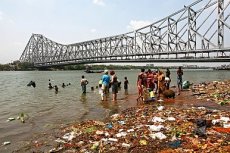Articles on Environmental Issues in India
 India has replaced China as the country with the largest number of cities in the world’s top 20 most polluted (in terms of air quality). That announcement has prompted a number of articles comparing the two countries and suggesting that India should learn from China — from both its past mistakes and its path forward. Certainly, there are some obvious similarities. An article in the Khaleej Times notes a litany of Indian environmental challenges that could easily have been lifted from an article on China: tap water that is not potable, massive mounds of plastic in landfills, and a devastating problem with e-waste. India’s water scarcity challenge also has begun to sound like that of China: More than half of India’s population faces “high to extremely high” water stress. Moreover, corruption plagues the environmental protection system in both countries. And the two countries, along with the United States, rank as the top contributors to global climate change.
India has replaced China as the country with the largest number of cities in the world’s top 20 most polluted (in terms of air quality). That announcement has prompted a number of articles comparing the two countries and suggesting that India should learn from China — from both its past mistakes and its path forward. Certainly, there are some obvious similarities. An article in the Khaleej Times notes a litany of Indian environmental challenges that could easily have been lifted from an article on China: tap water that is not potable, massive mounds of plastic in landfills, and a devastating problem with e-waste. India’s water scarcity challenge also has begun to sound like that of China: More than half of India’s population faces “high to extremely high” water stress. Moreover, corruption plagues the environmental protection system in both countries. And the two countries, along with the United States, rank as the top contributors to global climate change.
In response to their environmental challenges, China and India are also adopting many of the same measures. They are experimenting with tradable permits (in China for CO2 and in India for PM2.5), continuous air pollution monitoring and reporting from major cities and industries, the establishment of eco or smart cities, and higher fuel and vehicle emission standards, among many other initiatives.
Yet as compelling as the similarities between India and China may be, what is even more striking are the differences. First, the two countries are at significantly different stages of economic development: India’s per capita GDP is less than one quarter of China’s, so its economic development needs are greater than those of China. For India, the temptation may be greater to continue to sacrifice environmental protection to rapid economic growth, but the opportunities for an earlier course correction are also greater.
Enjoying this article? Click here to subscribe for full access. Just $5 a month.Second, and more important, is the difference in the two countries’ political systems. China is an authoritarian state and pursues a top-down approach to environmental protection, using the levers of political and economic control it possesses — state-owned enterprises, the Internet, and the Communist Party — to try to enforce its policies; the role of grassroots organization and public participation, as well as of the media, remain highly constrained. Beijing wants to address the people’s needs by reforming environmental policy, but it wants to control the nature, the pace, and the narrative of that reform.
India has no such ability — or perhaps even interest — to approach its environmental protection effort in this manner. A new book by India’s former Minister of State (Independent Charge) of Environment and Forests Jairam Ramesh, underscores the point. The book details Ramesh’s experience as head of India’s environmental protection effort for the past several years. For Ramesh, India’s political system is a defining feature in determining the evolution of the country’s environmental protection effort. The fact that he could write such a book — which is a compilation of his letters and reports on interactions with NGOs, the prime minister, and other government and business actors — with the subtitle “Ecology, Growth and Democracy in India” is the first indication of the gap in approach between the two powers. Qu Geping, the first chief administrator of China’s National Environmental Protection Bureau, has also written books on the environment but not ones that reveal the contemporary dynamics of Chinese environmental policymaking.









